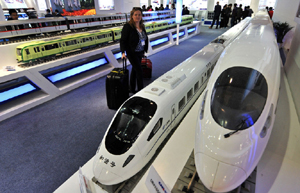

The country has also taken many supportive measures such as financial incentives for further developing bioenergy and biochemical industries.
However, compared with the US and Brazil, only 3 percent of China's petrol consumption has been replaced by ethanol fuels. Though the numbers are still small, China is the third largest adaptor of ethanol in the world after the US and Brazil.

The International Monetary Fund says there were 760 million cars across the world in 2010. By 2015, the figure is expected to reach 2.9 billion, with the bulk of the increases coming from countries like China.
Although China is the world's fifth largest oil producer, it has also been a net oil importer since 1993. In 2011, it imported more than 5 million barrels of crude a day, and accounted for 54 percent of the total demand.
Zhao of the Chinese consulate in Milan says that the government is committed to encourage the 1.5 and second-generation technologies to encourage the shift to non-food feedstock ethanol production.
Bloomberg New Energy Finance says that by 2030, 914 million tons of agricultural residues will be available in eight selected regions globally and can replace half of the global petrol requirements. In China 221 million tons of biomass including wheat, corn and rice residue will be available during the same period, making it the largest biomass producer in the world.
The second-generation plant in Anhui province will also pave the way for more green and renewable energy developments, Zhao says.
Non-grain biofuel progress is important for China, as it has to keep up with its emission goals and because of the caps on food-based biofuels, experts say. China now produces about 1.8 million tons of ethanol a year, accounting for just 2 percent of total petrol demand.
Some provinces like Shandong and Henan have started blending 10 percent ethanol with petrol in pilot projects. However, many problems hamper further development.
In theory, one can produce 337 kg ethanol from 1 ton of corn straw, but it largely depends on the transfer potential of the enzyme used. Enzymes account for the bulk of the production costs, and most of the cutting-edge technologies are still unavailable in China.
Another problem is cost-effectiveness. Mixing 10 percent ethanol with petrol leads to overall cost savings of just 2 percent, thereby indicating the need for further cuts in bioethanol production costs. Similarly it is difficult for first-generation plants to make a smooth transition to second-generation technology.
 Survey: Big strides in domestic auto quality
Survey: Big strides in domestic auto quality
 Auto Guangzhou witnesses new Porsche sports cars Asia Premiere
Auto Guangzhou witnesses new Porsche sports cars Asia Premiere
 Rise of the south's biggest show
Rise of the south's biggest show
 Sew be it
Sew be it
 Latest trend in tram
Latest trend in tram
 CCTV 2014 advertising auction kicks off in Beijing
CCTV 2014 advertising auction kicks off in Beijing
 Toyota TMEC opens hybrid tech R&D operations
Toyota TMEC opens hybrid tech R&D operations
 Toilet paper wedding dress to advocate low carbon lifestyle
Toilet paper wedding dress to advocate low carbon lifestyle